https://osalbishri.wordpress.com/2016/11/27/government-surveillance/#comment-80
https://zuowangsite.wordpress.com/2016/11/28/government-surveillance/#comment-62
Here is the link of my Storify for the topic The crowdsourcing.

On April 22nd, 2014, Starbucks decided to launch a white cups contest. This contest encourages customers in the U.S. and Canada to decorate a Starbucks cup with customized art, take a photo of it, and submit the design through social media using #whitecupscontest. The winning design will be printed on a limited edition Starbucks reusable plastic cup. It is a successful case of crowdsourcing because Starbucks received 4000 entries in just three weeks on the Twitter and Instagram. The crowd showed great eagerness and participatory on this project. Starbucks received wonderful visual content for their social media pages, and increased their social media reach. Here is the link of the introduction of the contest: Starbucks White Cup Contest.
In Asmolov’s article, people who are in the disaster area would use hashtags to achieve their civic engagement on the Internet. In White Cups Contest, hashtags are the same which are important tools for people to take part in this crowdsourcing process. Starbucks also make using social media the requirement. People must hand in their works by using Twitter or Instagram. Moreover, Internet users not only played a role as responder who contributes his or her resources, but also can appreciate others’ work by using #WhiteCupsContest. It is the same as what Asmolov said, “a subject can play different roles, as a recipient of information, as a sensor that can provide information, or as a responder who contributes his or her resources”(2015, p.175). In this way, people who search #Whitecupscontest can watch tweets only related to the white cups contest, which is a sort of classification. In other words, “it makes engagement more coordinated around particular objects”(Asmolov, 2015, p.163).
In my opinion, the second similarity between this case and the assigned articles is about the reasons that people take part in this contest. I think the reasons are accord with Brabham’s view. Firstly, the reason is related to the intrinsic motivation. I have seen an article on Starbucks website to interview the winner of the white cups contest in 2014. She said, “my work on the cup really represents who I am as an artist.” she also said that she was so enjoyable during the painting process. Therefore, it is the same as the saying that “to express oneself and to have fun are clear intrinsic motivators, fulfilling basic needs to have voice and enjoy oneself and enjoyment is a simple, powerful motivator”(Brabham, 2012, p.322). Moreover, many people who join this project said that it is fun. Secondly, the extrinsic motivation. In my opinion, making money is a significant motivation for people. Starbucks set a “25 cups of coffee and $300 gift card” as the reward, which is a big attraction for people.
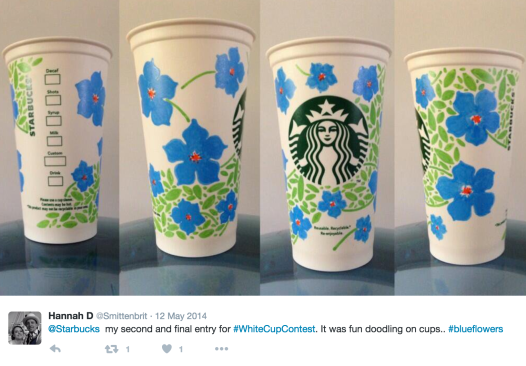
In additional, “participatory culture” was one of the most important factors that made this crowdsourcing successful. As Brabham said in his article, “participate culture is the culture with relatively low barriers to artistic expression and civic engagement, strong support for creating and sharing one’s creations”(2012, p.314), people who draw pictures on the white cups wasn’t require high painting skills. Moreover, it was easy and convenient to get a Starbucks white cups from any Starbucks in the U.S. Therefore, they were more passionate to create their own work, showing their imagination and creativity.
In a nutshell, it is a successful case of crowdsourcing. The white cups contest is held every year after 2014, helping Starbucks build their brand and attract people to buy their coffee due to their creative cups design.
Both Wijetunga(2014) and Wasserman(2011)’ articles mentioned how mobile Internet put effect on people’ daily life. And they both mentioned a concept called digital divide, which refer to unequal use of mobile Internet in Africa and Sri Lanka. However, they discussed about different reasons that cause digital divide.
The difference between Wijetunga and Wasserman’ articles is that Wijetunga’s article mentioned that “mobile internet can be used to fulfill various social functions, such as fun and entertainment, personal relationships, work, information access(Wijetunga, 2014, p.717).” To be specific, the privileged youth has access to social media whereas underprivileged youth to some extent couldn’t use such features of mobile phone due to their language level and lack of prior exposure to Internet.
In Wasserman’s articles, although mobile Internet is controlled mainly by political power and it causes many citizens get into the political process with limitation, Africa citizens did enjoy the benefit that “they use mobiles to text, transfer money, check market prices for agricultural products, monitor elections, send and receive public health or emergency messages, take photographs, make films, search the Internet, and, increasingly, for social networking(Wasserman, 2011, p.148).” Moreover, some social activists tend to use mobile internet for protests and activism. In a nutshell, people in Africa use mobile Internet to participate political activities better.
If I have a chance to create a study about mobile Internet, I will carry out a study which focus on how mobile Internet increase fragmentation reading during people’ daily life in China. This study will examine to what extent mobile Internet affect Chinese people’s reading habits. I will do this research on different mobile platform, such as Weibo, Wechat, QQ. The sample I concentrate on will be the youth, who aged between 12 and 30, including both male and female. Two main research questions will guide this study.
RQ1: Following the popularity of mobile Internet, how Chinese people’s reading habits change?
RQ2: How the change of people’s reading habit affect Chinese people’s other parts of daily life?
This topic is very important because fragmentation reading happened frequently in our daily life. People use their mobile Internet to watch news, connect with people, deal with their work problems. Most of these message are fragmented and patchy. When people using mobile Internet, they acquire message or entertainment quickly from texts, images and so on. This acquiring method cause people to get information like having a fast food meal. Additionally, this fragmentation reading habit has extra influence on people’ other parts of life. Therefore, this topic is meaningful. Moreover, the youth is the main force of using mobile Internet because they are eager to accept new things and they learn very fast. In other words, they are more affected by mobile Internet than elder people. Choosing this group of people to analyze is able to help me figure out typically to what extent people’ reading habits are affected by mobile Internet, and how this reading trend will put effect on individuals’ daily life and society.
The video materials come from a TV series called The Disguiser in China. In the original story, the leading actor and the leading actress didn’t have any love line. They were just partners. I changed the story line and edited this story. Moreover, I add four different styles of non-Chinese music to show different emotion of the Chinese characters in different periods of the story.
Collective action framing has been mentioned a lot of times in the Söderberg’s article, even as a part of the title. I have heard about collective action but collective action framing is totally different from it, basing on the article’s context. In my own words, I think collective action framing is a framework which provides goals and existing reason for hackers. It means that “how social movements construct narratives interpreting the world in a way that gives meaning to hackers’ struggles (Söderberg, 2013, p.1287).” It shows the rationality of hackers’ existence. The answer of why hackers doing their job and what hackers’ standpoint could be find in the meaning of collective action framing. I cannot find examples which accurately describe this concept. However, I found a example which can shed light on it partly. Russian hackers have released secret information about 25 Olympic athletes about drug problems recently. Even though many agencies thought that is illegal, hackers didn’t show any fear of laws and others’ judgment in response. That they chose to release such data on the Internet shows they tend to be an information-sharing groups. They generated intangible information online instead of produce actual product. Moreover, they focus on their enterprise and find warrant for themselves. This is a kind of collective action framing.

The term “piracy” was discussed by John (2014) in his article. To some extent, it is a concept that is used to be discussed together with “file sharing” often, especially on the Internet. Piracy means stealing others’ idea and works, even spread them in a wide range. Many people want to discern piracy and file sharing because they think file sharing should a fair action according to its literal meaning but piracy isn’t. Piracy is unfair and it will harm the original author’s right. In China, piracy phenomenon is so serious that the government and entertainment industry are struggling to repress it. The place where many piracy things happen is Baidu Cloud. It is a virtual store space which everyone can create their own space to store their resources. However, it means that many people can use it to share movie, songs and so on. Some movies which have been on in the foreign counties but have not been on in China will be spread through Baidu Cloud in advance for free. For people who used it, it can be a “file sharing”. However, for the government, the movie producers, the original singers, it is a kind of actual piracy.

I chose an article “The Internet is Not the Enemy”. The article is mainly about that different countries put forward similar policies to curb the Islamic State (IS) to recruit people on the Internet. The IS although is not a “nation”, it conquered more and more places across two countries, Iraq and Syria. In addition, it uses the Internet to spread its thoughts, disseminate terror videos, which show they were killing people, and recruit people all over the world to their cause. That is why many countries released policies in order to restrict the IS’s use on the Internet. The U.N. Security Council’s resolution toward terrorists and terrorism has been mentioned the most times. However, the author of this article believes that the U.S. government should attempt to repress terrorism by encouraging Internet companies, to improve their filters system for users, which enables them to choose what they do or do not wish to look at.
Firstly, the article accords with Shirky’s opinion to some extent. As Shirky said, “Activists in both repressive and democratic regimes will use the Internet and related tools to try to effect change in their countries, but Washington’s ability to shape or target these changes is limited”(2011, p.11), terrorists, in my opinion, can be defined as a specific group of activists, keep trying to access to the Internet. Although the government can influence their use of Internet for a while, it cannot work forever. They are easily to hide on the Internet. Therefore, that restricting the IS to use the Internet is not the perfect way to curb terrorism. It is more important to improve Internet users’ experience of choosing what they want to read and what they refuse to view.
However, it shows a contradictory between the U.S policy about curbing terrorism and improving Internet freedom, from the U.S’s policy of the Internet in the past. The reason is that the block of terrorism information will also affect some researchers’ research related to the IS and terrorism. Moreover, it is likely to provide the country with a motivation to limit the online freedom, in order to fulfill some political purpose.
As Comor and Bean said, “US foreign policy will remain largely determined by the country’s perceived political, economic, and military needs”(2012, p.216), the viewpoint can be supported by the article. Terrorism threat the U.S’ Internet users, even tries to recruit people from the U.S. One of its purposes is to separate the country. Therefore, US foreign policy that curbs the use of Internet of terrorist mainly fits the government’s political and military purpose. In light of this viewpoint, the U.S’s policy of hinder terrorists to use the Internet can be understood as a strategy to protect country security. Therefore, that “it is important to be clear that engagement is meant to be strategic rather than free-flowing”(Comon& Bean, 2012, p.205) is able to be confirmed by this article.
Here is the link of the article: ‘Racist’ Fox News piece blasted by Asian-Americans and people with basic sense of decency
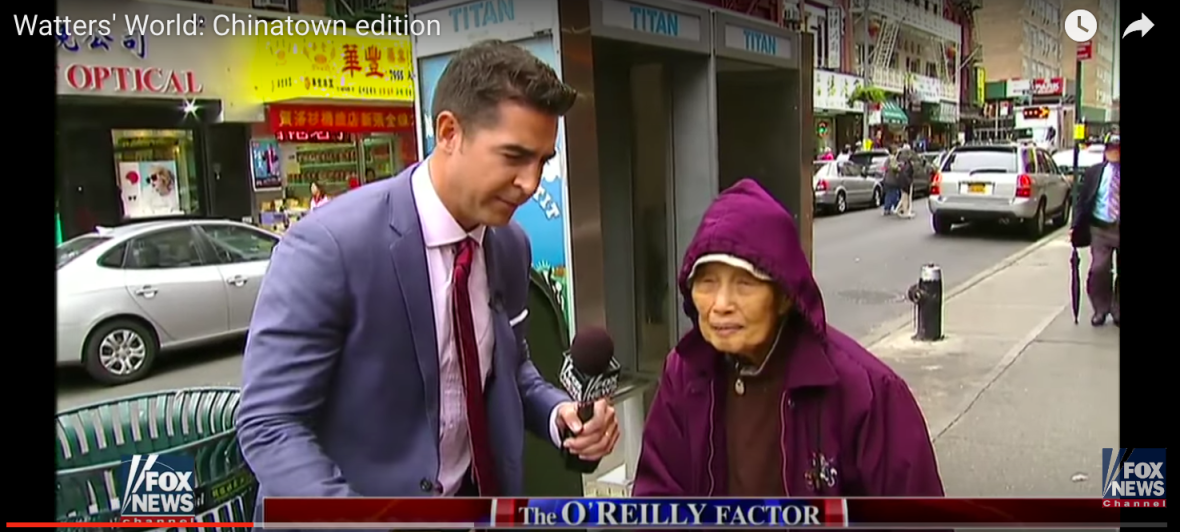
On October 3, One of the most famous TV programs, The O’Reilly Factor, broadcasted a “Chinatown” segment which mainly about interviewing Chinese people at Chinatown in New York. The journalist Watters poked unfunny fun at some Chinese people while asking them about the presidential campaign, with ridiculous film segments at the same time. This news gave rise to a great amount of protests and criticisms all over the Unite States, and became a virality in a very short period of time.
When I saw this news, I felt angry and ridiculous because Watters was impolite to Chinese people and China. This is what Berger and Milkman called, high-arousal emotion(2012). The content of the video makes many Asian-American angry because it is obvious assault and discrimination toward them. They felt being discriminated due to those awful questions. As a result, as Berger and Milkman said, “More anxiety- and anger-inducing stories are both more likely to make the most e-mailed list (2012).” When people felt angry about the news, they tend to disseminate it in a wide range. The news becomes more viral.
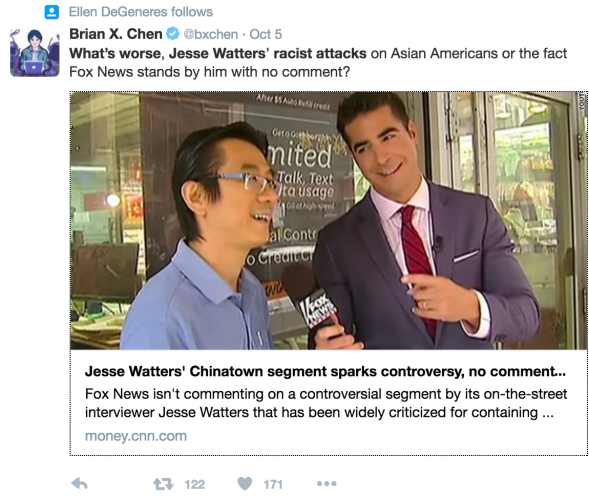
However, it doesn’t show that “the content of news is more likely to become viral the more positive it is (2012, Berger&Milkman, p.196).” As I see, this racist case is the most viral news at this week whereas it contained no positive content. Its political viewpoint is full of negative content since it has lots of discrimination toward Chinese. As a result, this case is a display of the opposite of that viewpoint. Moreover, I didn’t agree with that viewpoint that people tend to accept positive things. In my opinion, it depends on whether things are able to raise people’ resonance.
Next, let me discuss this case on the other aspect. “Informative (practically useful), interesting, and surprising articles are more likely to make the New York Times’ most e-mailed list (2012, Berger&Milkman, p.197).” It shows that people who facing practical, interesting, and surprising articles tend to express themselves with great likelihood. They desire to express themselves at that time. That is why confronting the racist news, a lot of people disclosed their opinions on Twitter. It also links to another facet that “social media users express their affective responses to online messages in ways that are visible to others (2014, Alhabash&McAlister, p.1319).” People are more likely to express themselves on the media where they have plenty of friends and their opinions can be seen by others. Twitter is a popular media platform, thus opinions released on Twitter about this case are countless.

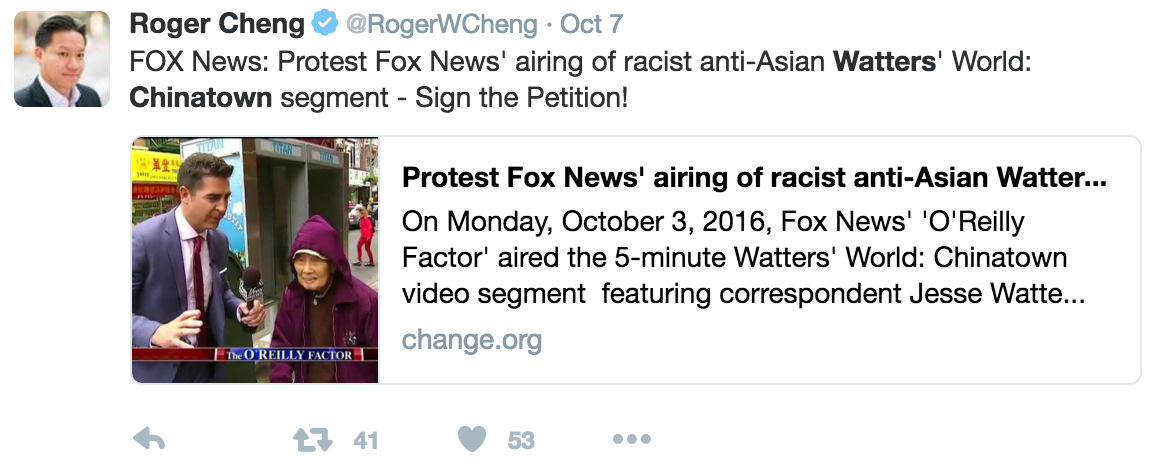
As Peretti said, “Human rights are inherently social (2013).” The content of case mentioned above obviously do not advocate human rights. Human rights contain race equality so this case violates this human rights principle. On the other hand, the racist case actually accord with some ways mentioned in Peretti’s blog. For example, “tell the world who you are and where you stand (2013, Peretti).” The O’Reilly Factor did told the world that they are racists. They also think about many idea that could attract people’ attention. Moreover, it is no doubt that the O’Reilly Factor tried to be humorous because they add plenty of film segments, albeit it is not funny at all.
In my opinion, The O’Reilly Factor are trying to attract more people’ attention because that Trump mentioned China 12 times is a hot topic now. However, it used improper way to produce this show.
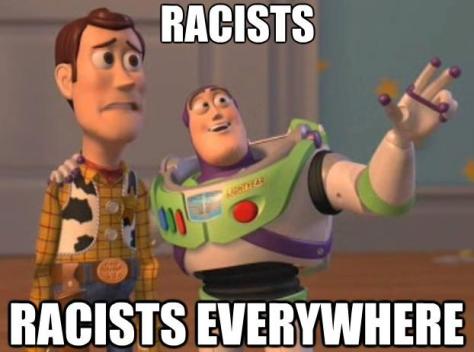

If I should explain algorithms to an 8 years old child, I would firstly ask him/her to play a scene game with me. We would pretend that we are in the Wendy’s and try to get some food for our lunch. I will tell her that when we get to the Wendy’s, our routine is firstly wait in line, then order a meal, wait for taking the food, finally get the food for lunch. Then I will ask her that whether we can get the meal without ordering, or can we just order the food but not wait in line. After she answer Yes or No, I will explain to her that it does not work if we cancel one of the steps because these three steps aim to ensure you to take the food away successfully. This process is similar to a process called algorithms, which is not only exist on the computer science field, but also emerge in our daily life, like the order of getting the food.
That algorithms are influencing important parts of our life is totally true. The most important part of my life must be Baidu. Baidu, the most popular search engine in China, which occupy my normal life whenever I want to search some information. Following the trend of commercialization, when I am searching, the information of the first line and the second line on the page are always advertisings. It shows a representative of algorithm that Baidu put these advertisings in a priority, and thus I, as a user, will see them at first. It would increase my possibility to click that title and enter that advertising page. Then, the deal between the Baidu and the advertising company can be finished.
This algorithm did sometimes help users to search useful information quickly and It often works because it has the priority. However, in my opinion, it is more like a limitation for users since choosing which company to be advertised, checking whether these company are legitimate, these work are all doing by Baidu themselves. The action of filtering company cannot be reliable because as a commercial company, they might choose company depends on money. The one who owns large amount of money does not mean that they are legitimate. If the company they choose to cooperate is illegal, the premise of this algorithm is bad and wrong. It cannot work. Therefore, this mechanism is more hurtful than beneficial.
From Crawford’s article, scene 2 resonated most with me because I often go shopping on the Amazon. Since I got to the U.S, I have bought many items from it, such as swimsuit, sunglasses, book and so on. I often see the “Customers Who Bought This Item Also Bought” part on the page, and it wastes me a lot of time because I am the one who cannot stop clicking the enter icon to watch more items which is recommended for me. For example, I bought a swimsuit last month. When I bought a swimsuit, Amazon recommended me with some swimming goggles and swimming caps. It showed that this algorithm worked because I was going to buy goggles and cap at that time. However, the algorithm did not work all the time. When I bought some fictions, it recommended me with other different kinds of fictions. Unfortunately, I did not like most of them. In my opinion, it is mainly because human’s interest and tendency too complex to set up a perfect algorithm to match although Amazon collects tons of data.

This week, I chose a shopping website, shopbop, where I usually do some shopping, to finish my observation. Here is its privacy policy. After reading its privacy policy carefully, I felt that I can not use it at random any more. However, I do not know how long will this feeling last. Additionally, I concluded three points which make me felt uncomfortable.

The first point is about my monetary inscurity. According to the shopbop’s privacy policy, I realized that when I bought some items from shopbop, my credit card information will be stored on its system forever. Also, it mentioned that it releases account and other personal information when it believes release is appropriate to comply with the law. However, in my opinion, its boundary is too obscure because it shows not only personal belief, but a leader’s decision. When I realize that whether our card’s information will be release or not is decided by a small amount of people, I felt a sense of distrust. Also, as Gary Kovacs said on Ted, “the consumer protection on the Internet is nearly naked.”
The second point that enables me to be wary is the unbalance relation between the company and the consumer. As the image displayed below, the “Information You Give Us” part contains content which is five times more than the “Information You can Access” part. Although I knew little about what information we will actually be monitored, the area which presented to me is obviously uneven. It feels like that everything we do on the Internet is being looked at.
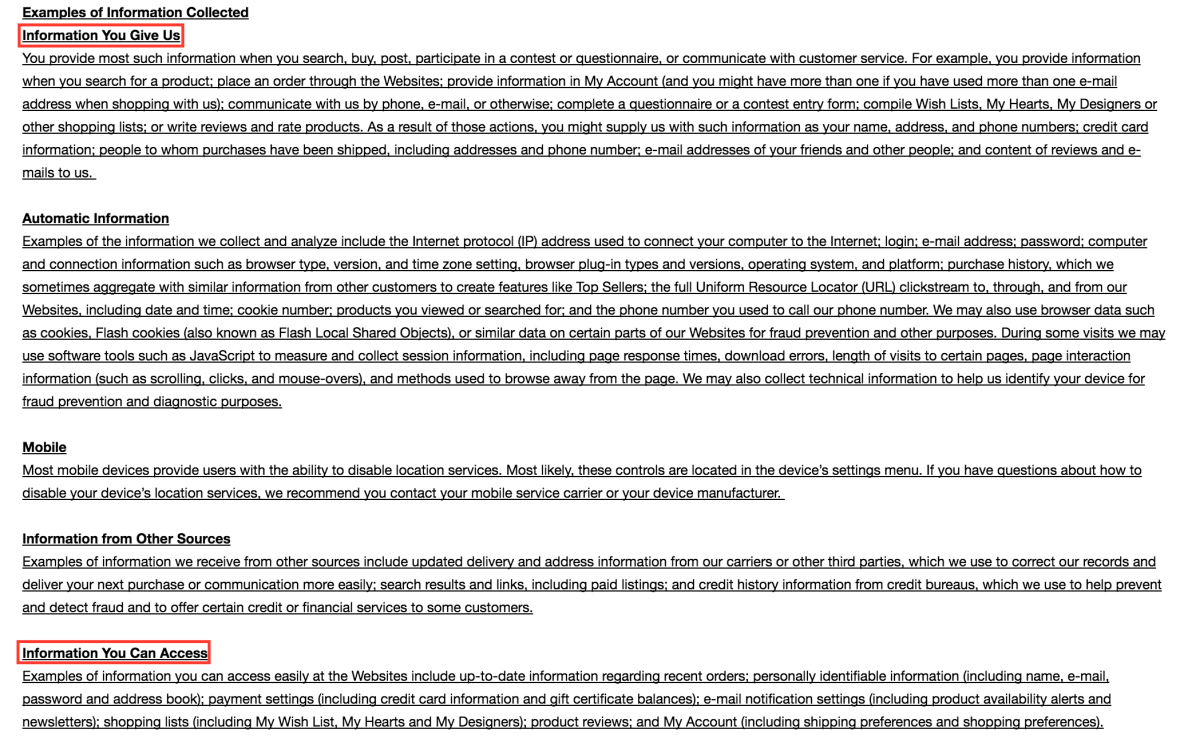
As for the email sending section, when I saw that policy, I felt ridiculous because It reminds me of an experience. I subscribed to shopbop’s latest information but after one week I tried to click the icon to cancel this subscription but although it showed I have canceled this kind of service, I still keep on receiving this subscription email. It disturbed me a lot. Therefore, I think its operate system shows some error and lack which annoy consumer a lot.
Teddicken said, “users usually do not allow their privacy concerns to influence their online behavior (2014, p.251).” I felt the same way because I felt uncomfortable about shopbop’s policies whereas I still would go shopping on its site because I am used to do it. Most of my friends always do some shopping on its sites as well. Therefore, there is a social relevance tie on its website. When I was in China, after I received my items from shopbop, I would release a Weibo and @shopbop to show what I got although it is sensitive information. In this way, shopbop connects with Weibo, where I think the social relevance is important. And my friends would come to comment me. During this process, I am able to communicate with my friends about the usage experience of items. Therefore, It is true for me that when more people think the social relevance of the Social Web is important, and the more they concentrate on the use of specific Social Web applications, the more information they disclose (Teddicken, 2014, p.267). It is not only on Weibo, but also on shopbop.
It is no doubt that now we are being tracked as soon as we use the Internet. However, what can we do? Internet is permeating our daily life.